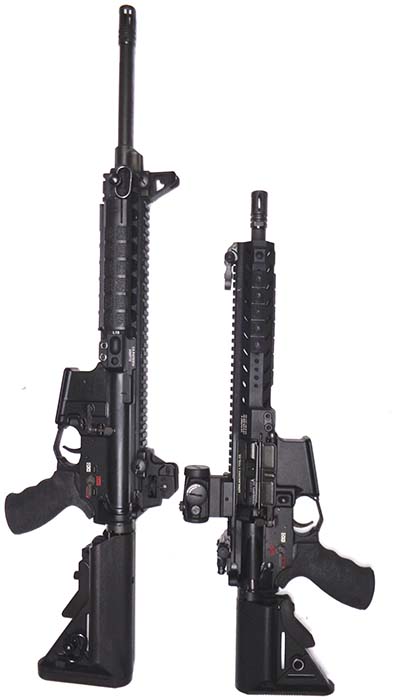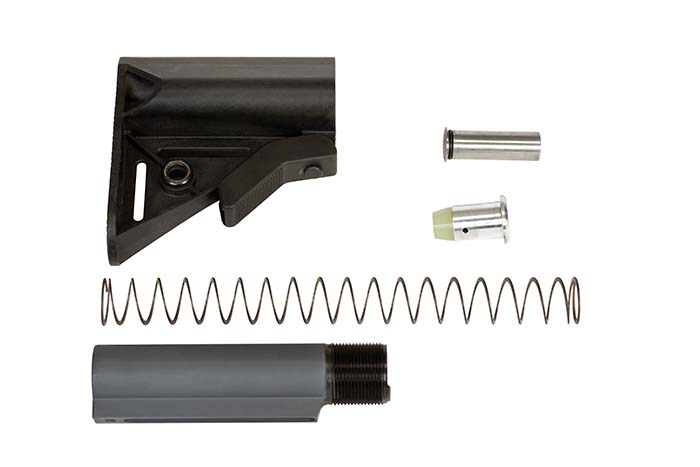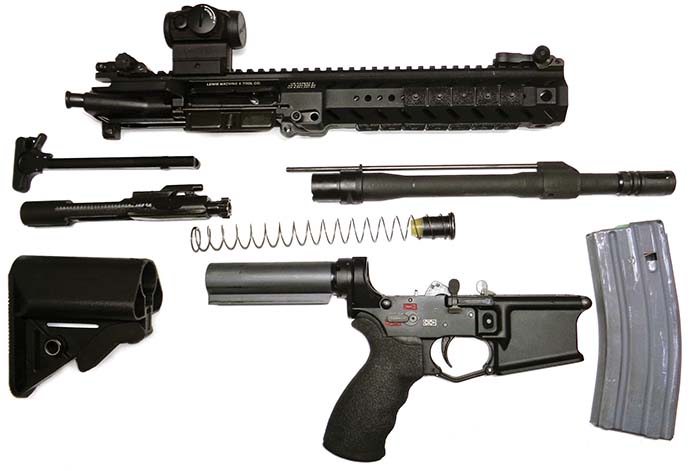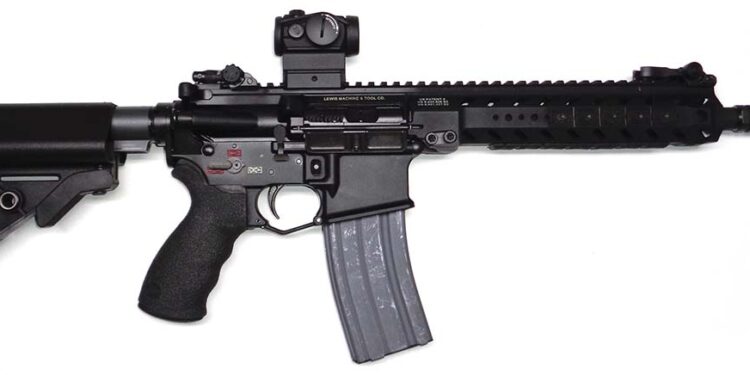By Christopher R. Bartocci
SHOT Show 2016 spawned many new innovative forearms. The Black Rifle Market is thriving as the AR15 continues to gain popularity and is still America’s rifle of choice. Lewis Machine & Tool continues to be on the cutting edge of Black Rifle developments and enhancements. Leading the industry with their Monolithic Rail Platform, LMT continues to add to their lineup in 2016 not only their new MARS rifle or Modular Ambidextrous Rifle System but their first complete PDW (Personal Defense Weapon). According to LMT, this is the shortest overall length of any rifle in the industry that uses a 10.5 inch barrel with an overall length of 24.3 inches with the stock fully collapsed and 27.6 inches with the stock fully extended. The PDW weighs 7.34 pounds empty! The PDW comes with a 10.5 inch barrel chambered in 5.56x45mm or 300 Blackout/Whisper. SAR was given a first look at the new LMT PDW. Our readers will be the first to look at and examine this exciting new development from Lewis Machine & Tool.

The lower receiver is offered in four different configurations. First is the standard Defender 2000 which is the standard semi-auto only mil-spec lower receiver. Next is the Guardian 2000 selective fire mil-spec lower receiver. Now it is available in the new MARS-LA which is the new fully ambidextrous selective fire lower receiver as well as the MARS-LS which is semi-automatic only. The rifle provided to SAR is the PDW with the MARS-LA lower receiver.
Starting with the upper receiver, the PDW uses an LM8CQB. The LMT MRP and LM8 series monolithic upper receivers are the only true monolithic upper receivers in the industry. Starting life with a solid 7075 T6 aluminum forging the upper receivers both have a continuous Mil-Std-1913 rail from the charging handle to the end of the upper receiver. The MRP has Mil-Std-1913 rails at 3, 6 and 9:00. The LM8 has removable rail segments which permit the user to only include rail where it is needed. This not only saves some weight but also width. There are rubberized grip pads that fit in the slots to provide a gripping surface for the hands. The upper receiver assembly has the forward assist, fired cartridge case deflector as well as ejection port dust cover. There are four quick-detach sockets for a sling adapter on the LM8CQB upper. The upper receiver is also equipped with LMT’s new folding back up sights. The front sight is the standard A2-type square front sight post. The rear sight is adjustable for windage as well as elevation out to 700 yards (also offered in metric). There is a “L” shaped aperture for short and long range. The windage drum is ambidextrous.
The charging handle is all new as well. LMT has introduced their ambidextrous charging handle. The Tactical latch is on both left and right side. There is also a gripping surface on the rear of the charging handle giving extra grip in harsh conditions.
The barrel in the test and evaluation rifle is the 10.5 inch CQB barrel for the MRP. This is the quick change barrel used in the MRP/LM8 weapons system. The front bolt is removed and rear loosened and the barrel assembly pulls straight out. The barrel assembly consists of the barrel, gas block, gas tube, barrel extension, crush washer and compensator. The barrel provided is the 5.56x45mm barrel with a 1 turn in 7 inch twist with 6 lands and grooves and a right hand twist. The barrel is chrome plated and test fired with a 70,000 PSI proof cartridge and then magnetic particle inspected to guard against stress fractures. Also offered is the 300 Blackout/Whisper barrel also. Same specification except 1 turn in 7 inch twist with 5 lands and grooves and a right hand twist. The faster spin is necessary to stabilize the 220 grain subsonic loads. Of course with the PDW using the LM8CQB upper, barrels can go from 10.5, 11.5, 14, 16 and 20 inches in length. The rifle can shoot 5.56x45mm, .204 Ruger, 300 Blackout/Whisper and 6.8mm Rem SPC.

The bolt carrier group is the first component we will discuss that makes the PDW different from anything else in the LMT line up. The receiver extension is significantly shorter than the standard receiver extension so this will require a much shorter buffer. There are some problems that arise with the shorter buffer. First is the action spring has to be altered also. Shorter buffer means shorter distance before the action spring will fully compress. The second issue is the shorter buffer will not have the space for the additional needed weight to cycle properly on fully automatic without bolt carrier bounce issues. So LMT figured out how to deal with all these issues. To deal with the recoil spring and shorter buffer, LMT switched to a flat recoil spring which allows more compression with less wire thickness and is stronger. So the combination of the new spring and shorter buffer took care of that issue. Now to deal with bolt carrier bounce. LMT designed a small insert that is inserted into the back of the carrier. This contains a large tungsten weight which absorbs the bolt carrier bounce like a standard H buffer would. This insert may go in any mil-spec bolt carrier without issue. It is held in the carrier by a rubber “O” ring. The PDW has been tested thoroughly on semi-automatic and fully automatic as well as suppressed with utter reliability. The cyclic rate of the PDW is 725 to 875 rounds per minute according to LMT.
As previously stated there are some options when getting a lower receiver. This rifle came with the brand new MARS-LA lower receiver introduced at the 2016 SHOT Show. This lower receiver is a natural product enhancement step but goes a little further for LMT. It has been accepted by the New Zealand Defense Force on their new general purpose rifles that are manufactured by LMT. The lower receiver has been reworked in several ways. Starting with the magazine well, it is flared and beveled to assist in low level to no light magazine insertion. The trigger guard has been made larger to accept heavy gloves in arctic environments. The rear of the receiver extension cap has a QD socket for a detachable sling swivel. The rifle has the LMT manufactured ambidextrous selector lever (safety lever). The ambidextrous magazine release is identical to their LM308MWS rifle. The button sits in front of the trigger on the left side of the rifle. The ambidextrous bolt catch sits right behind the magazine release on the right side and is easily reached by the right-handed shooter’s trigger finger. The ambidextrous bolt catch works very smoothly and is easy to use. The design of this lower is so that the shooter, whether right- or left-handed never has to release the firing hand from the pistol grip when reloading. The trigger in this lower is LMT’s proprietary selective fire 2-stage trigger mechanism. LMT makes these in-house with their newly acquired wire EDM machine. The trigger broke at 7 3/4 pounds on the T&E rifle. The pistol grip on this lower is the LMT Ergo grip which is the standard on all LMT rifles. This lower receiver is not a moment too soon, LMT now offers the most advanced upper receiver in the industry with the most advanced lower in the industry.

The receiver extension is part of the PDW system. Even being significantly shorter (2.75 inches) the receiver extension still has six positions as well as a drain hole. When the stock is fully extended it extends a total of three inches. The stock itself is a modified version of the famous LMT SOPMOD stock. The stock has been cut down and has eliminated the battery tubes. There is no rubber end plate to cut down on the overall length. The stock has two sockets, 1 on each side for a detachable sling swivel.
Not only does LMT offer this stock assembly on a complete rifle, they will be offering the subcompact PDW stock as an upgrade kit to mount on any lower receiver. Unlike the other sub-compact stocks on the market, there is no proprietary bolt carrier group. You just drop the weight pack in the back of your existing bolt carrier group. No special tools are needed for assembly. Just use a standard receiver extension nut wrench. LMT cut down on proprietary parts as much as possible. The same barrel extension plate and nut are used. The conversion kit will consist of the receiver extension, stock, buffer, action spring and carrier weight pack. The kit has an MSRP of $420.
LMT conceived the PDW to be ideal for VIP protection as well as military and law enforcement agencies in need of a smaller profile and increased maneuverability but with the accuracy and reliability of the AR-design. With a suppressor, the 300 Blackout/Whisper cartridge would rival any 9mm SMG on the market. The design was executed with a major emphasis on standard components with a combat system LMT has sold in over 35 countries.
The only product tested with the PDW was an Aimpoint Mod T-1 2MOA red dot scope. This is a miniature and lightweight optic ideally suited for such a small rifle. The site offers 1x magnification and the operating principal is a Reflex Collimator sight with an LED. The peak wavelength is 650± 10nm. The sight is night vision compatible and has a clear aperture of 20mm. The sight is powered by a CR123 battery with 5 years; 50,000 hrs of continuous use on position 8. The length of the sight is 2 7/16 inches in length with a diameter of 1 9/16 inches. The weight is just 3 ounces. The sight housing is manufactured from high strength aluminum and is anodized black. The LMT back up sights co-witness through the optic without issue.

The rifle was tested with a number of magazines to check for the compatibility with the new magazine well. The PDW was tested with Magpul Gen 3, Lancer AWM, Surefire 60 round, X-Products 50 round, Ultimag, Hera Arms, GI aluminum, Bulgarian IK-510, Hexmag and Elite Tactical systems. All magazines were loaded with the Mitusa USA Magazine Pump loader. When loading multiple magazines, it can get hard on the fingers. The magazine pump makes loading simple and easy. This author has been testing this loader for better than a year and loaded well over 10,000 rounds.
The LMT PDS was tested with several types of ammunition to ensure the short gas system with new buffer, action spring, bolt carrier weight and receiver extension worked properly. Ammunition was provided by Black Hills Ammunition, ZQI and HSM (Hunting Shack Ammunition). The Black Hills ammunition was 100 rounds of their .223 Rem 55gr FMJ new production ammunition as well as 50 rounds of their 5.56mm 77gr OTM (Mk262 Mod1). The 77gr is perhaps the most accurate factory loaded ammunition in the industry and most sought after load in SOCOM. The ZQI ammunition is manufactured by MKE in Turkey. It is 5.56x45mm NATO (62gr FMJ with penetrator core). This ammunition is quite popular and is competitively priced. There were a total of 100 rounds fired. The HSM ammunition is manufactured in Montana and they are known for high quality ammunition. They offer a large selection of loads in numerous calibers. This is new ammunition loaded to 5.56x45mm NATO specifications with the 62gr FMJ with steel penetrator core. The ammunition was loaded in Winchester primed military brass.

The PDW was tested on a 25 and 50 yard range. This is the basic close quarter battle distance. Anytime you have a short barrel you will get a large muzzle blast, the PDW was no exception. However it was not overpowering. The small size really made this weapon maneuverable. Much more so than a 14.5 inch rifle. For anyone mounted in a vehicle, this would be heaven sent. Many manufactures have gone with shorter barrels. LMT decided against this. The 10.5 is the shortest barrel you would want to go without sacrificing excessive terminal performance/penetration as well as reliability. Shorter barrels require shorter gas systems. This is hard on the components of the rifle due to higher cyclic rate and port pressures. LMT is very familiar with this issue due to Karl Lewis being the designer of the SOCCOM Mk18 10.5 inch barrel. Much research and development went into getting this reliable in all conditions.
During test firing, there were no malfunctions of any kind with either ammunition or magazines. LMT does not release a product until it has been thoroughly tested. The PDW functions as advertised and fits the roles for which it was designed. Now whether you are military or law enforcement, you have a new option for a super compact M4-type rifle. For commercial customers, they can get the exact same weapon in a semi-auto only configuration with either the standard Defender 2000 or MARS-LS lower receiver. Providing they get the proper NFA paperwork and tax stamp they can have the 10.5 inch barrel. Also, any of the mentioned customers can purchase the conversion kit and retrofit their existing rifle with the stock kit. It will function with any barrel length and most any bolt carrier variation as long as it is manufactured to mil-specifications. LMT continues to be on the leading edge of AR product development and we always look forward to seeing what Karl Lewis will come up with next.
| This article first appeared in Small Arms Review V20N9 (November 2016) |












